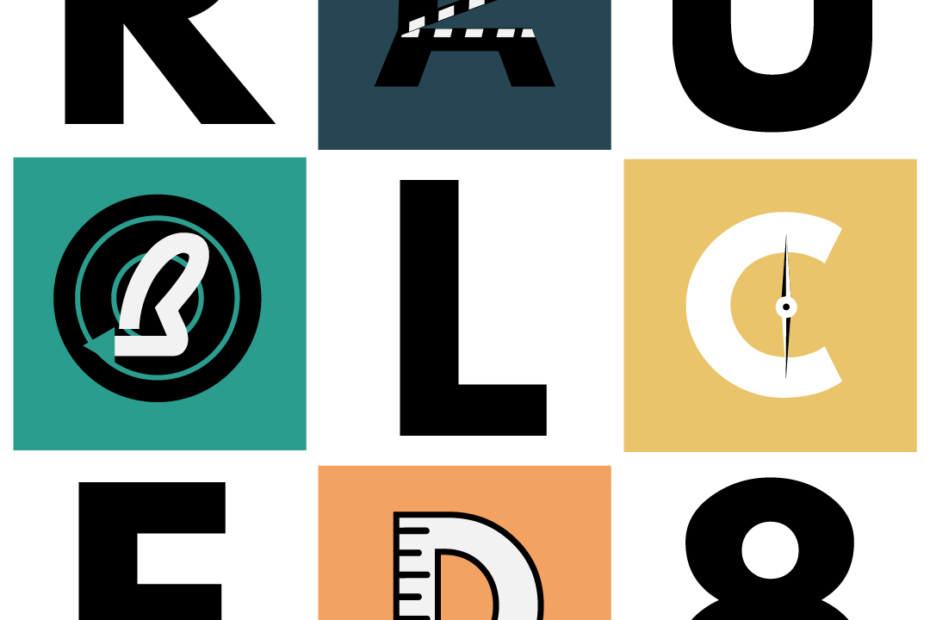We asked our Instagram followers to tell us which COLREGS rule was most confusing. For those that have been trying to learn the rules for a while, it is probably no surprise that most people asked for an explanation of COLREGS Rule 8 – Action to avoid collision.
COLREGS rule 8 as easy as ABC;
A = Action
B = Big enough
C = Course/Close Quarters
D = Distance
E = Engines
F = Frigging confuuuuuuuuuusing.
Rule 8 (A)- Action
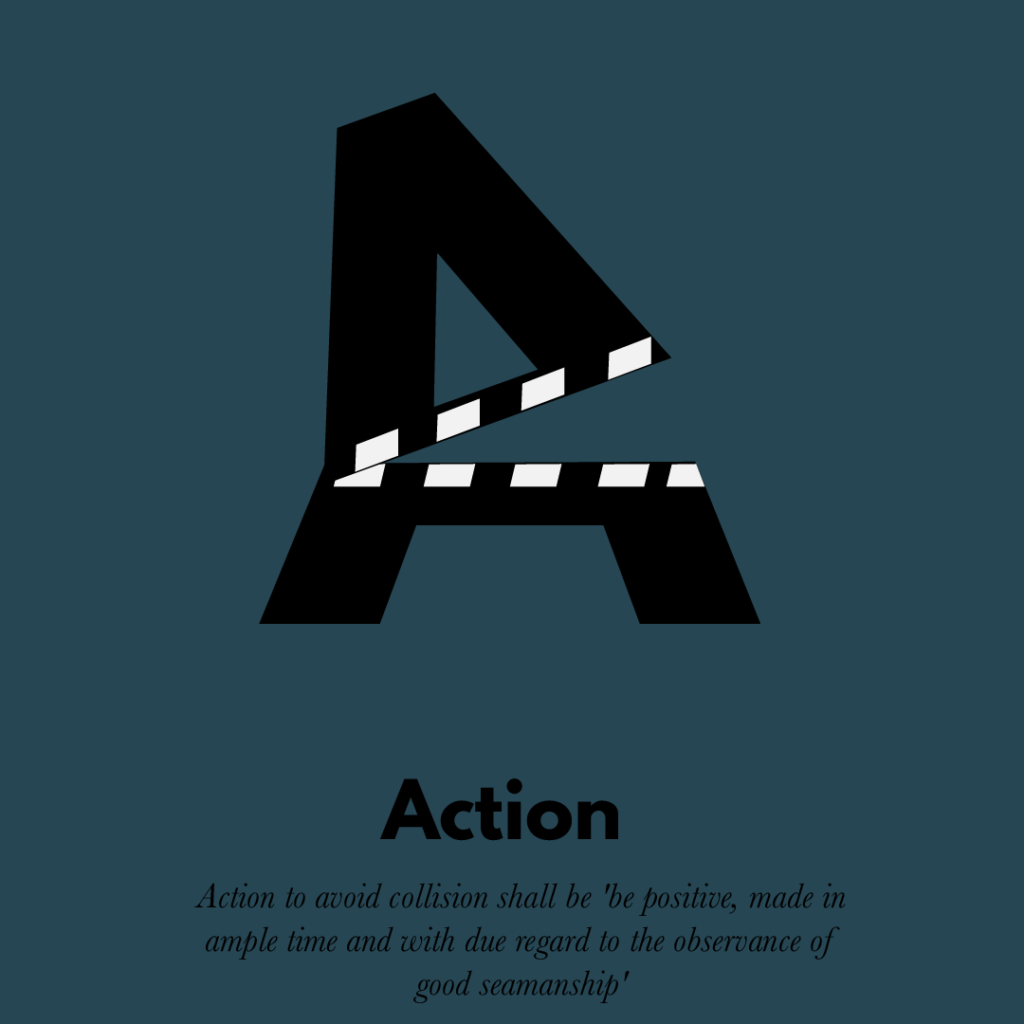
COLREGS Rule 8 (A) is an overarching rule that tells us how to behave when we are taking action to avoid collision.
- Any avoiding action has to follow the rules. This might seem obvious but it is an important part of the rule. The first sentence of 8(a) prevents vessels from solely applying rule 8 and ignoring other rules such as rule 17 – action by stand-on vessels. Without rule 8 (a) it would be possible for a stand-on vesselThe word 'vessel includes every description of water craft, including non-displacement craft, WIG craft and seaplanes, used or capable of being used as a means of transportation on water'. to alter course at any time and therefore confuse already established crossing situations.
- When avoiding collision ‘positive action’ shall be made in ‘ample time’. If you imagine driving your car down the road and you see a cat in front of you. The cat sees your car and freezes in the middle of the road. There is a moment where neither you or the cat know what the other is going to do next, and this moment makes it all the more likely that you will hit the cat. Rule 8 (a) is telling us that by taking positive action in ample time we can prevent confusion and reduce the risk of collisionThe term risk of collision is described in Rule 7. 'Every vessel shall use all available means appropriate to the prevailing circumstances and conditions to determine if risk of collision exists. If there is any doubt such risk shall be deemed to exist.' More.
- Due to the number of possible situations that the COLREGs need to be applied in there is a requirement fir users to consider the current circumstances. Like many of the rules, 8 (a) includes the phrase “when the circumstances of the case admit†allowing for instances where specific actions may not be possible due to other factors.
Key Phrase – Action to avoid collision shall be ‘be positive, made in ample time and with due regard to the observance of good seamanship’
8 (B) – Big enough

It can be very tempting to edge your speed down or alter a couple of degrees at a time until you get a CPA t. IGNORE this temptation. This is about communicating your intention through action, the other vessel must be able to confidently say they have observed you alter IAW the Rules.
When making an alteration of course consider what it might look like from the other vessel’s perspective. Where possible you should turn to show a different bow aspect, such that at night a vessel would see a change in sidelights'Sidelights' means a green light on the starboard side and a red light on the port side each showing an unbroken light over an arc of the horizon of 112.5 degrees and so fixed as to show the light from right ahead to 22.5 degrees abaft the beam on its respective side. In a vessel of less than 20 meters in length the sidelights may be combined in one lantern carried on the fore and aft centreline of the vessel. More.
A succession of small alterations of course and/or speed is often cited as one of the causes of a collision
. The incident between Beijing Bridge and Saxon Onward (2018) is one of many examples of how an early and positive action could have prevented a collision.
Key Phrase – large enough to be readily apparent to a vessel observing visually or by radar.
8 (C) – Course/Close Quarters
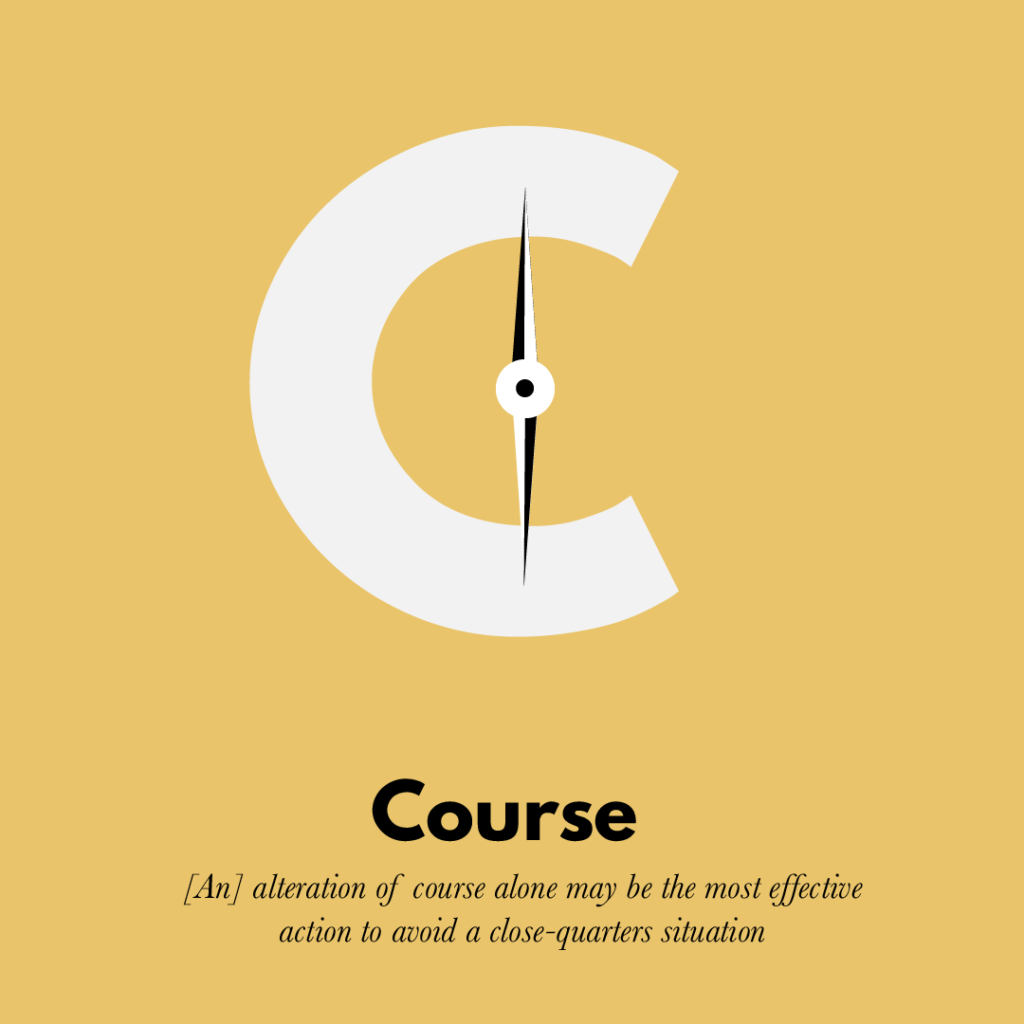
This rule talks specifically about alterations of course to avoid collision stating that they ‘may be the most effective action’.
- There are some other reasons why an alteration of course alone may be preferable. For most large vessels an alteration in course can be achieved in less time than a change in speed. It is also much easier for another vessel to observe this alteration, particularly when vessels are in sightVessels shall be deemed to be in sight of one another only when one can be observed visually from the other. of one another.
Key Phrase – alteration of course alone may be the most effective action to avoid a close-quarters situation
8 (D) – Distance

Every time you make an alteration of course/speed to avoid a collision you should be confident that the result will be a comfortable CPA. Check this after you make your alteration and continue to do so until the risk of collision has passed.
Key Phrase – Action taken to avoid collision … shall be such as to result in passing at a safe distance.The effectiveness of the action shall be carefully checked until … finally past and clear.
8 (E) – Engines
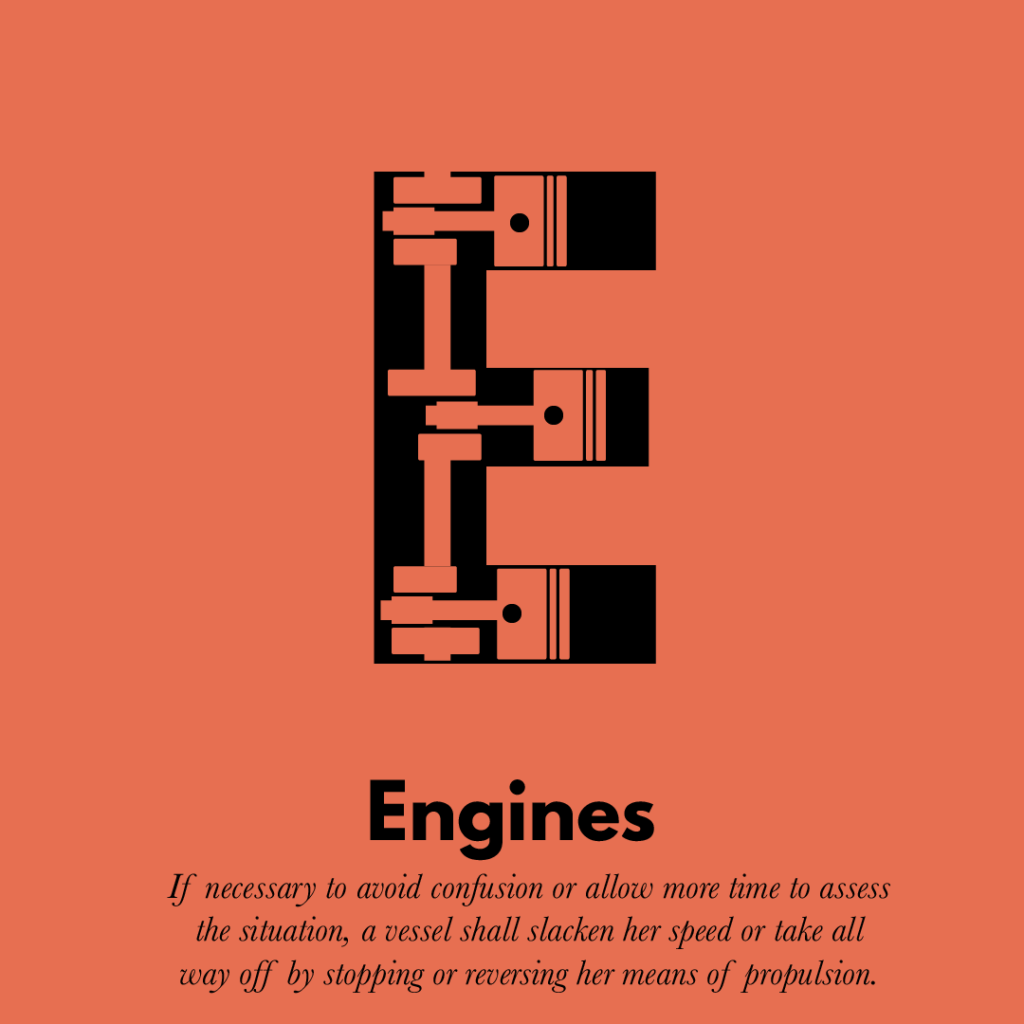
- This Rule tells you that slowing down or stopping is ALWAYS an option. You can do it to avoid collision or you can do it if you just need more time to figure out what is going on.
- Slower relative speed, means greater time to CPA and critically more time to assess the situation, call the Master'A vessel's Master' is the formal term for the Captain. The Master of a vessel is responsible for its safe operation in harbor and at sea. A 'Master Mariner' is not necessarily the same as 'A vessel's Master'. Master Mariners hold the highest level of seafaring qualification and often work as Pilots or Masters of large vessels. More/Captain to the bridge.
- This is all engine related, to stop you would either stop your engines or set them astern.
Key Phrase – If necessary to avoid confusion or allow more time to assess the situation, a vessel shall slacken her speed or take all way off.
COLREGs Rule 8 (F) – Friggin Confusing
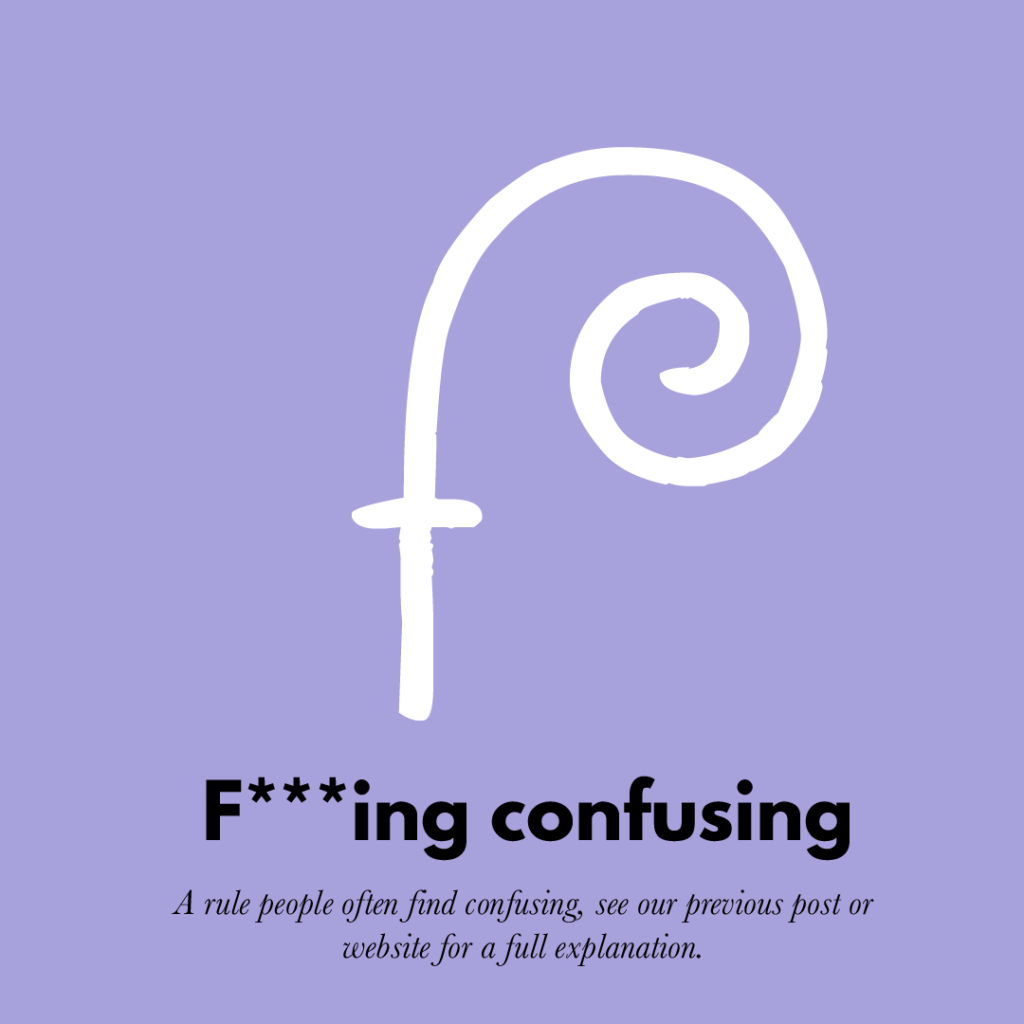
Confusing at first glance but once you break it down really quite simple. This Rule refers specifically to situations where one vessel is required “not to impede†the “passage or safe passage†of another.
This situation only exists in 3 specific scenarios
- In or near a narrow channel
- In or near a TSS
- When encountering a vessel CBD
Part I
F(i) Says if your vessel is required not to impede, take action early so the other vessel has enough sea room for a safe passage. Considering the circumstances we’re looking at above, enough sea room for a safe passage can be considered as the channel, lane or restricted water that a vessel is navigating in, ideally they would not need to deviate from their course in any way.
Part II
F(ii) Adds an extra layer on top, now we still have the circumstance where one vessel is required not to impede, but also a risk of collision between two vessels.
For example Rule 9 states a pdv shall not cross a narrow channel or fairwayA fairway means an open area of navigable water that is often maintained by an authority i.e a port or harbour. More if it impedes the safe passage of a vessel that can safely navigate only within it. However these vessels are now approaching so as to involve risk of collision and in a crossing situation.
Even though he is the “stand on vessel†in this crossing situation. He isn’t off the hook and still must take action so as to not impede the other vessel. In doing so he must also consider the action they are likely to take. I.e should the giveway vessel take action it is likely to be a reduction in speed or alteration to STBD if sea room allows. Therefore the vessel outside the channel should avoid an alteration to Port and favour a reduction in speed or alteration to STBD.
Part III
F(iii) Looks at the perspective of the vessel whose passage is not to be impeded. It says as soon as a risk of collision exists you act as you otherwise would IAW the rules. Regardless of the fact they are required to avoid impeding you, if you are the burdened vessel you must take action.
For more examples and guidance see our COLREGS Rule 8 (F) Explained article.
If you found this article useful please share it with a friend. We want to hear about other areas of the COLREGs that you find difficult. Send us a message, we’d love to chat.
